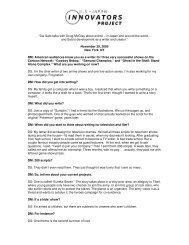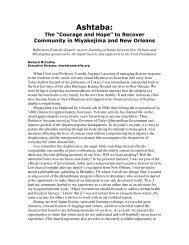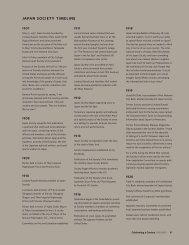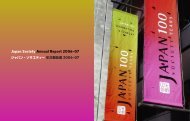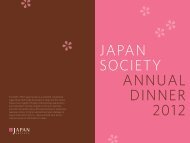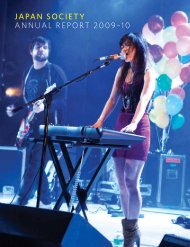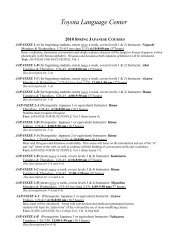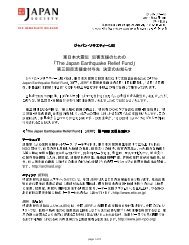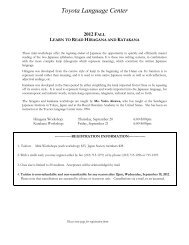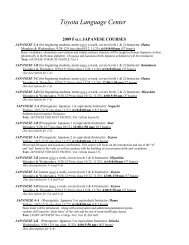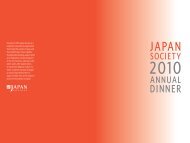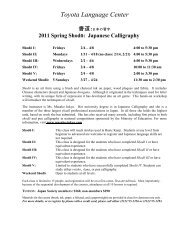Programs (PDF) - Japan Society Annual Report 2008â09 1
Programs (PDF) - Japan Society Annual Report 2008â09 1
Programs (PDF) - Japan Society Annual Report 2008â09 1
Create successful ePaper yourself
Turn your PDF publications into a flip-book with our unique Google optimized e-Paper software.
Toyota Language Center<br />
The <strong>Society</strong>’s <strong>Japan</strong>ese language education program, which<br />
began in 1972 with just a single class, has grown into one<br />
of the largest and most respected in the nation. Today, the<br />
Toyota Language Center offers 12 comprehensive levels of<br />
<strong>Japan</strong>ese, as well as a variety of specialized courses and<br />
workshops including shodo (<strong>Japan</strong>ese calligraphy), ensuring<br />
that there is a class for any level of <strong>Japan</strong>ese student. In<br />
addition, the Center caters to native <strong>Japan</strong>ese speakers by<br />
providing three levels of English conversation (ESL) classes<br />
and a <strong>Japan</strong>ese Language Teacher Training Program at the<br />
beginning and intermediate levels.<br />
C.V. Starr Library<br />
The C.V. Starr Library houses approximately 14,000 volumes,<br />
in addition to a language library and an impressive rare<br />
book collection. Its holdings include a comprehensive<br />
collection of books (primarily in English) on <strong>Japan</strong>ese art,<br />
history, culture, society, politics, economics, religion and<br />
many other subjects. An ideal place for research on <strong>Japan</strong><br />
and <strong>Japan</strong>-U.S. relations, the library has also become one<br />
of the favorite attractions of <strong>Japan</strong> <strong>Society</strong> visitors.<br />
Shodo II student. © Satoru Ishikawa.<br />
2008–09 Language Classes<br />
Mini-Workshops: Learn to Read Hiragana &<br />
Katakana<br />
25, 26 September<br />
21, 22 January<br />
28, 29 May<br />
Enables beginning students to master efficiently<br />
the reading of hiragana and katakana.<br />
<strong>Japan</strong>ese Language Courses<br />
29 September–12 December<br />
26 January–3 April<br />
1 June–14 August<br />
Twelve levels of <strong>Japan</strong>ese, from beginning to<br />
advanced.<br />
English Conversation Courses<br />
2 October–9 December<br />
3 February–7 April<br />
5 May–23 June<br />
9 July–27 August<br />
Three levels of English as a Second Language<br />
(ESL) in 30- or 38-hour sessions.<br />
Kanji I, II, III<br />
29 September–12 December<br />
26 January–3 April<br />
1 June–14 August<br />
Designed to enable those proficient in <strong>Japan</strong>ese to<br />
read <strong>Japan</strong>ese newspapers with ease.<br />
Economics & Business:<br />
Advanced Reading Course I<br />
30 September–9 December<br />
27 January–31 March<br />
2 June–11 August<br />
Guides advanced language students in reading the<br />
Nihon Keizai Shimbun and the <strong>Japan</strong>ese versions of<br />
Newsweek and Forbes, and also covers important<br />
business customs.<br />
Intensive <strong>Japan</strong>ese Weekend Courses<br />
8, 9, 15 & 16 November<br />
7, 8, 14 & 15 March<br />
13, 14, 20 & 21 June<br />
Total immersion for people who plan to travel or<br />
move to <strong>Japan</strong> or for students unable to attend<br />
regular weekday classes.<br />
Intensive Practical <strong>Japan</strong>ese: Business & Culture<br />
27 April–27 May<br />
Helps students master the fundamentals of<br />
<strong>Japan</strong>ese conversation, with special emphasis on<br />
business and social occasions.<br />
<strong>Japan</strong>ese Language Teacher Training Program<br />
23 April–26 May<br />
Teaches essential classroom teaching skills to<br />
native and fluent speakers of <strong>Japan</strong>ese who have<br />
had little or no formal training in the teaching of<br />
<strong>Japan</strong>ese as a second language.<br />
<strong>Japan</strong>ese Language Teacher Training<br />
Follow-Up Program<br />
7 October–9 December<br />
A continuation of the teacher training program,<br />
providing the skills necessary to teach <strong>Japan</strong>ese at<br />
the intermediate level.<br />
Shodo Workshops I, II, III , IV &<br />
Advanced Course<br />
29 September–12 December<br />
26 January–6 April<br />
20 April–29 June<br />
13 July–21 September<br />
A hands-on workshop on the techniques of shodo,<br />
a calligraphic art form that uses a brush and<br />
charcoal ink on paper, wood plaques and fabric.<br />
Weekend Shodo<br />
5 October–2 November<br />
29 March–26 April<br />
10 May–7 June<br />
19 July–16 August<br />
A hands-on workshop on the techniques of shodo<br />
on Sundays, offered because of the demand for<br />
these popular courses.<br />
<strong>Japan</strong> <strong>Society</strong> <strong>Annual</strong> <strong>Report</strong> 2008–09 36



